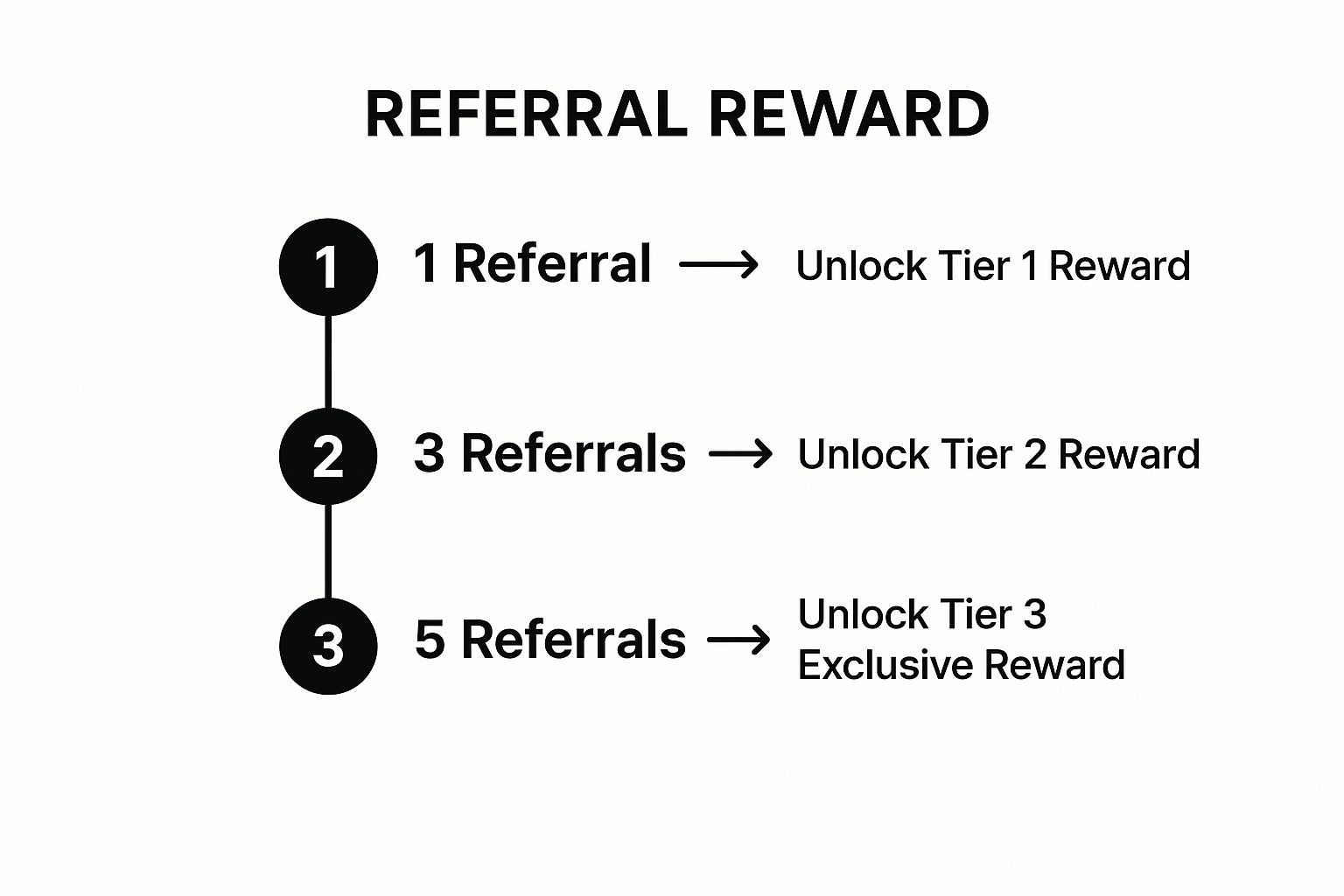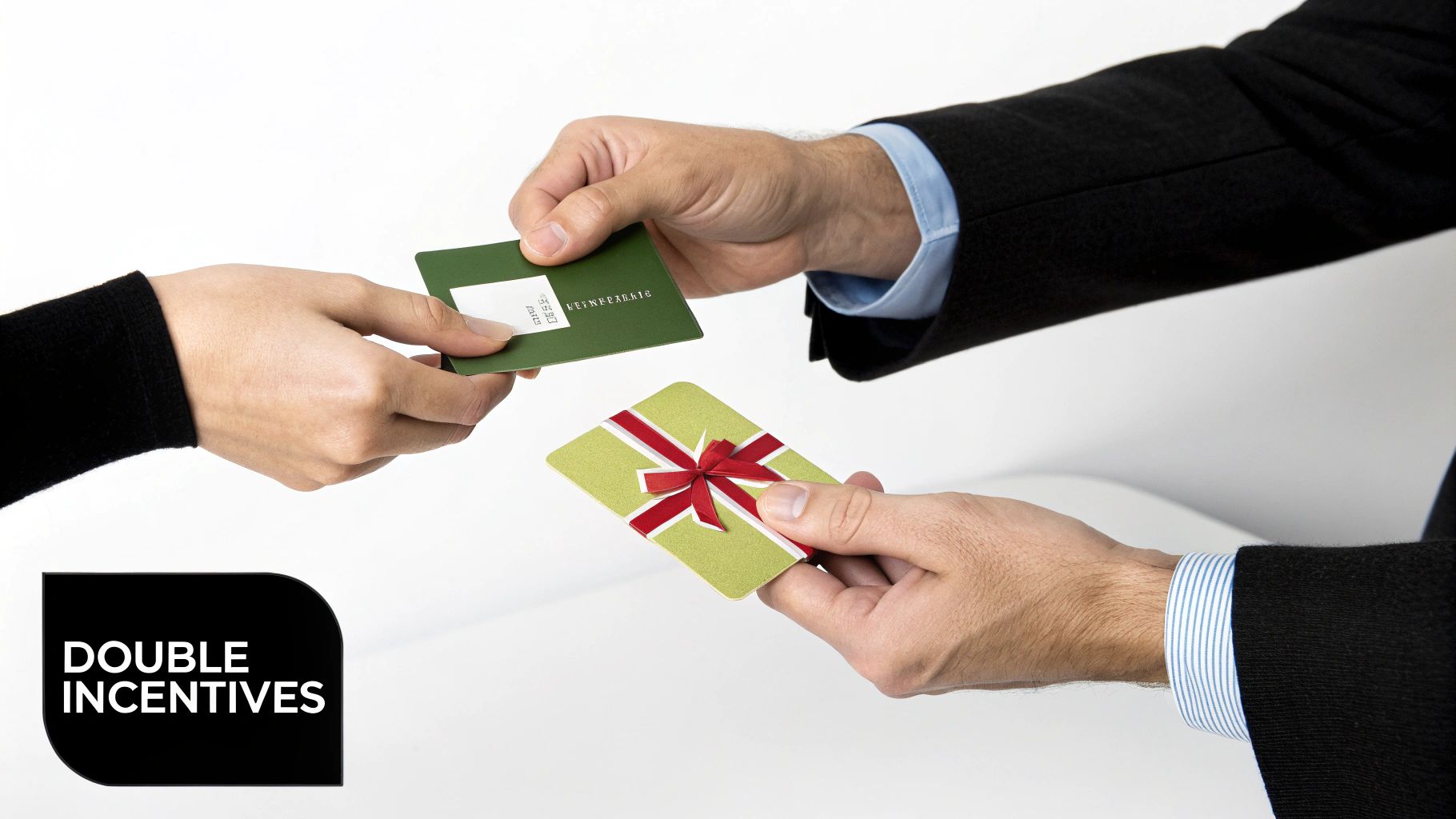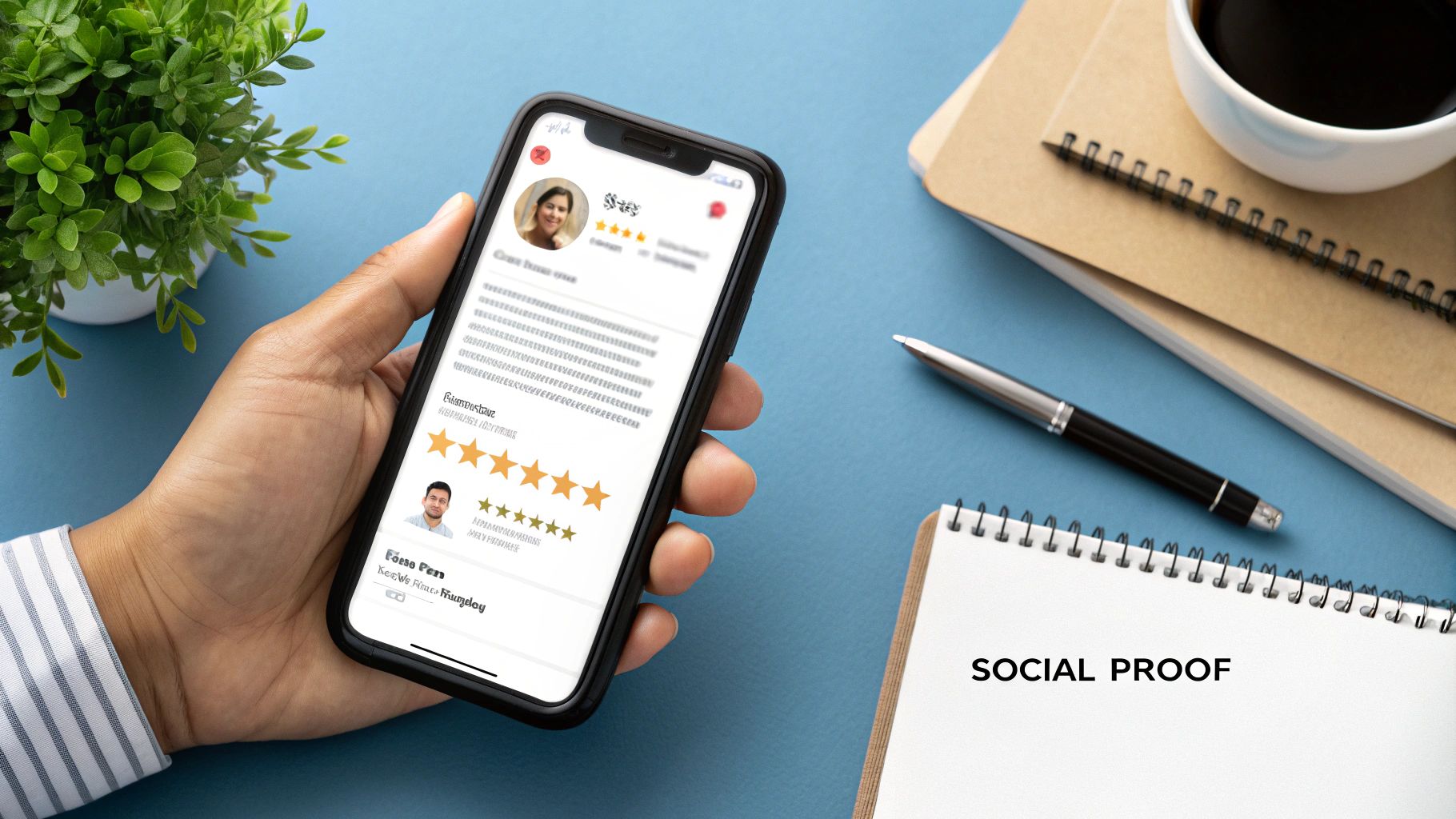Harnessing the power of word-of-mouth is no longer a passive strategy; it's a core growth engine. For SaaS businesses, a well-structured referral program can dramatically lower customer acquisition costs and attract highly qualified leads who already trust your brand. The challenge isn't recognizing the value of referrals, but designing a system that actively encourages and rewards them. Generic "share with a friend" buttons are no longer enough to cut through the noise. Success requires a deliberate, creative, and strategic approach.
This article moves beyond basic concepts to provide a curated list of actionable marketing ideas for referrals. We will break down specific, implementation-ready strategies tailored for the unique dynamics of SaaS, from tiered reward structures that incentivize power users to integrating referral features directly into your product for a seamless experience. Each idea is designed to be a blueprint, helping you build a referral machine that fuels sustainable growth. To further enhance these efforts, understanding broader technological trends is crucial, such as those covered in an ultimate guide to artificial intelligence in marketing. Get ready to transform your satisfied customers into your most effective marketing channel.
1. Tiered Reward Referral Programs
A tiered reward program moves beyond the simple "one referral, one reward" model. It creates a structured, gamified system where the value of the reward increases as a customer successfully refers more people. This approach taps into the human desire for achievement and status, encouraging your most enthusiastic advocates to become super-referrers. Instead of a single, static incentive, you create a ladder of rewards that motivates continued engagement over time.
This strategy is particularly effective for SaaS businesses because it fosters long-term advocacy. By offering escalating rewards, you not only acquire new customers but also deepen the loyalty of your existing ones. It transforms a one-time action into an ongoing challenge, making it one of the most sustainable marketing ideas for referrals.
How to Implement a Tiered Program
- Define Clear Tiers: Start with 3-4 distinct levels. Too many can be confusing, while too few may not feel challenging enough. Make the first tier easily attainable to provide an initial win and build momentum.
- Vary Your Rewards: Mix tangible and intangible rewards. Early tiers might offer account credits or a month of a premium feature. Higher tiers could unlock exclusive swag (like Morning Brew's famous mugs), early access to new features, or even a one-on-one strategy call with an expert from your team.
- Visualize Progress: Implement a visual progress bar or dashboard within the user's account. This allows referrers to see how close they are to the next reward, reinforcing their motivation to keep sharing.
The following infographic illustrates a simple, three-tier progression to help visualize how a customer journey through the program might look.

This visual flow demonstrates how a well-structured program guides users from an initial, easy-to-achieve reward to more exclusive, high-value incentives.
For more on building a program that people genuinely want to participate in, this video provides excellent insights into the psychology behind successful referral systems.
2. Double-Sided Incentive Programs
A double-sided incentive program, also known as a dual-sided referral, is a strategy that rewards both the existing customer who makes the referral and the new customer who signs up. This creates a powerful, mutually beneficial loop where both parties have a compelling reason to participate. The referrer feels good about sharing a valuable offer, and the new user receives an immediate benefit, reducing the friction and hesitation often associated with trying a new service.

This approach is one of the most effective marketing ideas for referrals because it equips your advocates with a tangible gift they can give to their network. Instead of just asking for a favor, they are offering real value. Dropbox famously used this model, offering both referrer and referee 500MB of extra storage, which was directly tied to their product's core value and fueled their explosive early growth.
How to Implement a Double-Sided Program
- Balance the Rewards: Ensure the incentive is attractive to both parties. While the rewards don't have to be identical, they should feel fair and valuable. An unbalanced offer, where one party gets a significantly better deal, can reduce motivation.
- Make Rewards Relevant: The best rewards enhance the user's experience with your product. Think account credits, access to premium features, or, like Dropbox, more usage capacity. This reinforces product value rather than just offering a generic cash reward.
- Communicate Clearly: Your messaging should instantly clarify the "give one, get one" nature of the offer. Use simple, direct language like, "Give your friends a 20% discount and get $25 in credits for each one who signs up."
- Ensure Fast Fulfillment: The magic of this model lies in instant gratification. Automate the reward delivery so both users receive their incentive immediately after the referral action (like a completed signup or first payment) is confirmed.
3. Social Proof Integration
Social proof integration leverages public validation to supercharge your referral efforts. Instead of keeping referrals a private, one-to-one interaction, this strategy makes them visible. By publicly showcasing referral activities, testimonials from new users, and success stories, you tap into a powerful psychological trigger: people are more likely to do something if they see others doing it and benefiting from it. This approach builds immense trust and credibility around your brand and your referral program.
This method transforms referrals from a simple transaction into a community-building activity. It’s a perfect fit for SaaS companies, especially those with strong communities like Peloton or product-led growth models, as it showcases real users achieving success. Seeing peers benefit from a referral provides powerful, authentic motivation, making this one of the most effective marketing ideas for referrals.

How to Implement Social Proof Integration
- Create Sharable Moments: Design your referral process to be inherently social. When a new user signs up via a referral, prompt both the referrer and the new customer with pre-written, easily shareable social media posts. Brands like Warby Parker excel at this by encouraging customers to share photos with their new glasses.
- Showcase Success Stories: Actively collect and feature testimonials from customers who joined via referral. Dedicate a section of your website or blog to these stories, highlighting the value they received. Peloton’s member spotlights are a masterclass in turning individual success into community-wide inspiration.
- Build a Branded Hashtag: Create a unique, memorable hashtag for your referral program (e.g., #YourBrandFriends). This consolidates all user-generated content into a single, explorable feed, creating a living wall of social proof that new prospects can discover.
- Engage and Amplify: Don't just wait for content to appear. Actively monitor your branded hashtag and mentions, then like, comment on, and reshare user posts. This engagement validates your customers' contributions and encourages more people to participate.
4. Milestone-Based Referral Campaigns
A milestone-based referral campaign connects your referral program to a specific business achievement, product launch, or seasonal event. Instead of running a continuous, static program, this approach creates time-sensitive campaigns that generate excitement and a sense of urgency. By tying referral incentives to a moment of celebration, you invite your customers to share in your success and give them a compelling reason to act now.
This strategy is highly effective because it feels authentic and celebratory, rather than purely transactional. When a company like Slack hits a major user milestone or Buffer launches a new feature, a special referral campaign leverages that positive momentum. It makes sharing feel like part of an exclusive event, turning it into one of the most timely marketing ideas for referrals.
How to Implement a Milestone Campaign
- Align with Genuine Milestones: Tie your campaign to authentic events like a company anniversary, hitting a revenue or user goal, or launching a significant product update. This ensures the campaign feels genuine and celebratory.
- Create Time-Bound Urgency: Clearly define the start and end dates for the campaign. A limited-time offer, such as "double rewards for the next 7 days," encourages immediate action from your user base.
- Offer Exclusive Rewards: Develop unique, milestone-themed rewards that aren't available during regular periods. This could include special edition swag, a larger-than-usual account credit, or exclusive access to the team behind the new feature.
- Promote Extensively: Announce the campaign across all your channels: in-app notifications, email newsletters, social media, and blog posts. Build anticipation before the launch and send reminders before it ends to maximize participation.
By strategically planning these campaigns around high-engagement periods, you can create powerful bursts of referral activity. For a deeper dive into structuring these kinds of initiatives, you can learn more about referral program best practices on refgrow.com.
5. Influencer-Driven Referral Programs
An influencer-driven referral program is a powerful hybrid strategy that merges traditional referral marketing with modern influencer partnerships. Instead of relying solely on existing customers, this approach leverages the established trust and reach of content creators and industry experts. These influencers receive specialized referral codes or links, along with enhanced rewards, for promoting your product to their dedicated audiences.
This strategy is highly effective for SaaS businesses aiming for rapid market penetration and credibility. By partnering with a respected voice in your niche, you can instantly tap into a pre-built community that trusts their recommendations. It’s one of the most scalable marketing ideas for referrals because it allows you to reach thousands of potential customers through a single, authentic source, bypassing the slower growth of one-to-one referrals.
How to Implement an Influencer Program
- Identify the Right Partners: Focus on influencers whose audience and values align perfectly with your ideal customer profile. Use tools to analyze their engagement rates and audience demographics, prioritizing relevance over sheer follower count. Micro-influencers often yield higher engagement and a more targeted audience.
- Provide an Authentic Experience: Give influencers genuine, extended access to your SaaS product. A real, unscripted experience enables them to create authentic content that resonates with their followers, rather than a generic ad read. This authenticity is key to driving meaningful conversions.
- Create Unique, Trackable Codes: Assign a unique referral code and tracking link to each influencer. This is essential for accurately measuring performance, attributing sign-ups, and managing commission payouts. It also provides clear data for boosting influencer marketing ROI by showing which partnerships are most effective.
- Balance Guidelines with Creative Freedom: Provide a clear brief covering key messaging points and FTC disclosure requirements, but allow influencers the creative freedom to present your product in their own voice. Their audience follows them for their unique style, and micromanaging the content can feel inauthentic.
For a deeper dive into identifying the right partners, explore this guide on how to find bloggers and creators in your niche. Learn more about finding the right partners on refgrow.com
6. Community-Powered Referral Networks
A community-powered referral network shifts the focus from transactional exchanges to fostering an ecosystem where referrals happen organically. Instead of solely relying on individual incentives, this approach involves building or nurturing a dedicated space where customers can connect, share experiences, and advocate for your product based on genuine relationships and shared value. The community itself becomes the engine for advocacy, driven by trust and peer-to-peer validation.
This strategy is exceptionally powerful because it builds a defensive moat around your brand. When customers feel like they are part of an exclusive group, like Sephora’s Beauty Insider Community or Harley-Davidson's HOG, their loyalty deepens, and their recommendations carry more weight. This transforms passive users into active brand evangelists, making it one of the most authentic marketing ideas for referrals.
How to Build a Community-Powered Network
- Provide Value First: Your community's primary purpose should be to serve its members, not just to promote your product. Focus on facilitating valuable discussions, sharing expert knowledge, and helping members connect. This builds the foundation of trust necessary for organic referrals.
- Encourage Authentic Conversations: Create prompts and channels that encourage genuine user-generated content and peer-to-peer support. When members solve each other's problems using your product, the recommendations are built-in and highly credible.
- Recognize and Empower Superusers: Identify your most active and helpful community members. Empower them with special roles, early access to features, or exclusive swag. These "ambassadors," like those in Lululemon’s programs, become powerful and trusted advocates.
- Offer Community-Exclusive Perks: Introduce referral bonuses or contests that are only available to community members. This reinforces the value of being part of the group and encourages members to tap into their networks on behalf of the community.
7. Automated Email Referral Sequences
An automated email referral sequence is a sophisticated marketing tactic that moves beyond a single, generic referral request. It uses marketing automation to send a series of personalized emails at key moments in the customer lifecycle, strategically asking for a referral when a user is most satisfied and engaged. By leveraging behavioral triggers, purchase history, and product usage data, these sequences deliver the right message at the perfect time.
This approach is highly effective for SaaS companies because it operationalizes word-of-mouth marketing. Instead of hoping customers remember to refer, you proactively prompt them after positive experiences, such as achieving a milestone or using a key feature successfully. This makes it one of the most scalable and precise marketing ideas for referrals, ensuring no opportunity is missed.
How to Implement Automated Email Sequences
- Identify Key Moments: Pinpoint high-satisfaction points in your customer journey. Triggers could include a user reaching a usage milestone (like Grammarly celebrating a writing streak), successfully completing onboarding, or consistently using a high-value feature.
- Personalize the Ask: Don't send a generic blast. Reference the specific achievement or action that triggered the email. For example, “We saw you just used our reporting feature to create 10 dashboards! Glad you’re finding it useful. Know anyone else who could benefit?”
- Make Sharing Effortless: Embed pre-populated sharing links directly within the email. Include clear call-to-action buttons for email, social media, and a simple copy-paste referral link to remove all friction from the sharing process.
- Segment Your Audience: Not all users are created equal. Create segments based on user engagement levels, subscription plan, or NPS scores. Focus your primary referral efforts on your most active and satisfied customers, as they are most likely to become powerful advocates.
Companies like HubSpot and Canva have mastered this by integrating referral asks seamlessly into their user communication. For instance, a user who exports multiple designs from Canva might receive an automated email celebrating their creativity and inviting them to share Canva with friends for a premium element credit. This contextual approach feels helpful, not pushy.
8. Product Integration Referral Features
Product integration referral features embed the act of sharing directly into the core user experience, making it a natural and seamless part of using your service. Instead of sending users to an external landing page, this approach allows them to refer others without ever leaving the product environment. It capitalizes on moments of high engagement and satisfaction, turning product usage itself into a powerful referral engine.
This method is exceptionally effective for product-led growth (PLG) companies where collaboration and team expansion are central to the user's success. By weaving referral prompts into the workflow, you reduce friction to near zero. Tools like Slack and Notion have perfected this by making "inviting a teammate" synonymous with using the product more effectively, demonstrating how powerful integrated marketing ideas for referrals can be.
How to Implement Integrated Referral Features
- Identify High-Satisfaction Moments: Pinpoint where users experience the most value. This could be after they complete a key task, achieve a milestone, or use a collaborative feature. Place referral prompts at these "aha!" moments. For example, Zoom prompts users to invite others directly within a meeting.
- Frame Referrals as a Benefit: Position the invitation as a value-add, not a sales pitch. Instead of "Refer a Friend," use language like "Invite a Teammate to Collaborate" or "Share this Project with a Colleague." This makes the action feel helpful and contextually relevant.
- Offer Multiple Sharing Channels: Provide various ways for users to share directly from the interface, such as by email, generating a unique link, or inviting from a contact list. This flexibility accommodates different user preferences and workflows.
- Test Placement and Triggers: Continuously test where and when you present the referral option. The goal is to be helpful without disrupting the user's primary task. A/B test different prompts, button placements, and triggers to find the most effective combination.
For companies looking to build these features, understanding the landscape of integration platforms can be a significant advantage. To explore how different tools can connect and enhance your product's capabilities, you can learn more about SaaS integration platforms on RefGrow.com. This knowledge helps in creating a more cohesive and powerful in-product referral experience.
Referral Marketing Strategies Comparison
| Referral Program Type | Implementation Complexity 🔄 | Resource Requirements ⚡ | Expected Outcomes 📊 | Ideal Use Cases 💡 | Key Advantages ⭐ |
|---|---|---|---|---|---|
| Tiered Reward Referral Programs | High - requires tier setup and ongoing optimization | Medium-High - automation and reward costs | High engagement and increased referrals | Businesses aiming for gamified, sustained participation | Motivates repeat referrals; sense of achievement |
| Double-Sided Incentive Programs | Medium - balanced reward management | Medium - rewards for both parties | Higher conversion; lowered acquisition friction | Companies focused on quick conversions and mutual value | Boosts conversion rates; positive user experience |
| Social Proof Integration | Low - content creation and sharing tools | Low - mainly marketing and content efforts | Builds trust and organic brand credibility | Brands leveraging user-generated content and testimonials | Low cost; enhances credibility and virality |
| Milestone-Based Referral Campaigns | Medium - campaign planning and promotion | Medium - limited-time rewards and marketing | Creates urgency and campaign-driven buzz | Businesses celebrating launches or events | Drives excitement and leverages business momentum |
| Influencer-Driven Referral Programs | High - influencer management and contracts | High - influencer fees and content collaboration | High reach and trust-based conversions | Brands expanding via influencer audiences | Access to engaged audiences; professional content |
| Community-Powered Referral Networks | High - community building and management | Medium-High - ongoing engagement and support | Long-term loyalty and authentic advocacy | Brands cultivating strong customer communities | Trust-based referrals; self-sustaining advocacy |
| Automated Email Referral Sequences | Medium-High - marketing automation setup | Medium - email platform and content creation | Scalable, personalized referral outreach | SaaS and product businesses with robust email lists | Scalable; data-driven optimization |
| Product Integration Referral Features | High - product development and UX considerations | High - development resources and maintenance | Seamless referrals and high engagement | Digital products seeking natural referral triggers | Minimal friction; real-time feedback and tracking |
From Idea to Implementation: Activating Your Referral Marketing Engine
We've explored a powerful spectrum of referral marketing ideas, moving far beyond the basic "give a discount, get a discount" model. From the scalable motivation of Tiered Reward Programs to the viral potential of Double-Sided Incentives, the path to a high-performing referral engine is paved with strategic, customer-centric thinking. Integrating social proof, automating outreach, and embedding referral features directly into your product aren't just isolated tactics; they are interconnected components of a holistic growth strategy.
The core takeaway is that the most effective referral programs feel less like a marketing campaign and more like a natural, valuable part of the user experience. They understand customer motivation, reward meaningful actions, and leverage the inherent trust that exists between peers. For SaaS businesses, this is not a "nice to have" but a critical competitive advantage. A well-executed referral system transforms your happy customers into your most authentic and effective sales force.
Your Actionable Roadmap to Referral Success
To turn these concepts into tangible results, focus on these immediate next steps:
- Audit Your Customer Journey: Identify the "aha!" moments where customers are most delighted with your product. These are the perfect opportunities to present a referral offer. Is it after they complete a key project, hit a usage milestone, or receive positive feedback from their own team? Pinpoint these moments and build your referral prompts around them.
- Choose Your Starting Model: Don't try to implement all eight ideas at once. Select one or two that best align with your current business stage and product type. An early-stage startup might benefit most from a simple but powerful Double-Sided Incentive Program, while a more established platform with an active user base could launch a Community-Powered Referral Network to amplify existing engagement.
- Define and Track Your KPIs: What does success look like? Go beyond just tracking the number of referred users. Monitor key metrics like the conversion rate of referred leads, the lifetime value (LTV) of referred customers versus non-referred customers, and your overall viral coefficient. This data will be crucial for optimizing your program over time.
Mastering these marketing ideas for referrals is about more than just acquiring new users. It's about acquiring the right users, the ones who are more likely to be loyal, engaged, and profitable because they were introduced by someone they trust. By building a systematic, thoughtful, and rewarding referral program, you create a sustainable, scalable, and cost-effective growth channel that strengthens your brand with every new customer it brings in.
Ready to put these marketing ideas for referrals into action without the engineering headache? Refgrow provides the complete toolkit to launch, manage, and scale any type of referral program discussed in this article, from tiered rewards to automated sequences. See how our platform can help you build a powerful referral engine in minutes at Refgrow.

